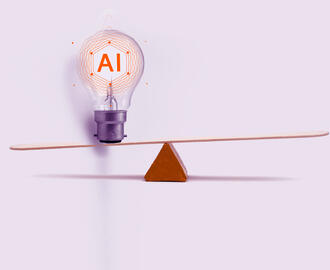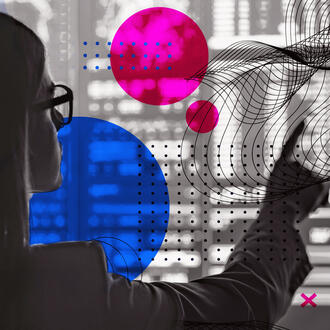Credit: Rob Dobi
Workers have long been disrupted by new technology, from typesetters giving way to automated printing processes to bank tellers and the rise of ATMs. Historically, new technology has led to greater productivity as displaced workers shift to new tasks —typesetters might become graphic layout artists, while bank tellers focus on more complicated banking services.
The current era of automation has been different, according to researchers. As new digital technologies become commonplace, productivity has stagnated and fears about unemployment have become widespread.
According to MIT professor and Boston University’s Pascual Restrepo part of the problem is what they call “so-so technologies”: advances that disrupt employment and displace workers without generating much of a boost in productivity or quality of service —think self-checkout kiosks at grocery stores or automated customer service over the phone.
“Automation technologies, by their nature and design, displace workers from the jobs they were previously performing,” Acemoglu said. Technologies that replace workers while increasing productivity can be painful, but at least they deliver value, Acemoglu said.
So-so technologies don’t even do that, he said — “they're not really improving productivity or reducing costs.” Tesla’s decision to fully automate its California assembly plant is a good example, Acemoglu said. The automation model led to delays and malfunctions, and Tesla’s founder, Elon Musk, later admitted it was a mistake.
As Acemoglu and Restrepo detail in a recent paper, automation affects the labor market in some predictable ways. Automation replaces workers in various tasks they’ve previously performed, accounting for a displacement effect. In many cases, substituting machines for human labor leads to economic expansion and an increased demand for labor in non-automated tasks as the cost of production goes down. This is called a productivity effect.
In other instances, technologies complement human workers, helping them become more productive in their current job tasks. For example, imaging tools help medical experts make quicker and more accurate diagnoses.
So-so technologies replace workers without offering any strong benefits, Acemoglu said.
As a new MIT report on the future of work points out, businesses have a role to play in reversing this trend and shaping the future for workers, including by avoiding so-so technologies.
“[If] all you do is automate something which is lousy, you’re going to get a lousy result,” said John Kelly, chief technology officer at IBM, at a Washington, D.C. event introducing the report.
Businesses should be thinking about the workforce as a whole when they introduce technologies, Kelly said. “How do we advance the technology, but [also] how do we intelligently insert it into the workforce, and how do we bring the workforce along?”
The first step is to understand the drivers that cause companies to adopt ineffectual technologies in the first place. Acemoglu identified four main reasons companies invest in so-so technology.
1. Shifting costs to consumers.
Some so-so technologies shift costs from companies to consumers, as when grocery shoppers spend time ringing up and bagging their own groceries. Automated telephone customer service is another example, Acemoglu said.
Most of these automated services do not work well and are not popular with customers, Acemoglu said. People often have to wait or press the right sequence of numbers to talk to a person who can actually solve the issue they are having.
But companies like airlines, which don’t face much competition in the U.S., continue to invest in such services, which take jobs away from customer service professionals.
“It doesn't satisfy customers all that much. Customers are not saying ‘I want to use this company more because they have [automated] customer service,’” Acemoglu said. “It’s cutting costs to some degree. But because of the [low] quality of the service, the cost cutting is not that powerful either.”
2. Minor gains.
Companies might invest $1 million in slightly productive technology when they would have paid the same amount to workers, Acemoglu said. So-so technology like self-checkout kiosks might be slightly productive in the sense that they don’t negatively impact a company’s bottom line, even though workers are displaced and there are no significant gains.
“Companies are not internalizing the social cost that they create by displacing workers,” Acemoglu said.
Companies aren’t losing money through self-checkout kiosks, he said, but any improvement is minimal. “Right now, self-checkout kiosks are slower, the scanners don’t work very well, the system gets stuck all the time,” Acemoglu said.
He noted that some so-so technology could become productive technology in the future. “I think in 10 years’ time, or 15 years’ time, we’ll have such advanced self-checkout kiosks that they can actually read what’s in your cart without you working very hard or scanning it, and then that would be a really efficient, seamless process of self-checkout,” he said. “But we’re not there yet.”
3. Following the hype.
In some cases, companies invest in automation because they’ve misjudged its potential.
“There's a lot of hype, and that hype means that companies are overstating or overestimating the benefits they're going to get from some of these technologies,” Acemoglu said. “And as a result they are over-automating.”
“I think the hype has to be a critical component of explaining why Tesla did what it did,” Acemoglu said of the car company’s automation push. “It was like the perspective of Silicon Valley exported into car manufacturing.” He said early applications of artificial intelligence tend to fall into an automation for automation’s sake category that do not yet lead to strong productivity gains.
4. Long-term strategy.
Some companies are willing to invest in technology that might not improve their bottom or line or productivity for the sake of long-term strategy.
“They’re saying ‘Fine, we’re not going to get much gain at the moment, but that means we’re going to be gathering a lot of data,’” Acemoglu said. “’We’re going to learn by doing, we’re going to perfect the technology. And in 10 years’ time we’ll be ahead of the game.’”
For the economy to expand, though, companies need to either avoid so-so technology or mitigate its impact. Acemoglu outlined two main ways to do that:
Think outside the box
Companies can avoid so-so technology by opting not to follow the herd mentality toward automation, Acemoglu said. “A lot of excessive adoption of automation technology is part of that herd behavior. It’s the ‘in’ thing,” he said. “The hype is do more AI, do more automation.”
Taking time to think about the impact can guide companies toward technology that is higher quality and productive. “If you say no, I want to think outside the box, and I want to find new ways of using technology. I think it would really help,” Acemoglu said.
For example, German manufacturing companies that adopted industrial robots worked hard to find other ways to use skilled workers. “How can we find other jobs for these workers inside the company so that we don’t waste their talent, their training, and their dedication,” Acemoglu said.
Think more about workers
One solution seems obvious but is a hard sell, Acemoglu said: Companies should think about their workers as much as they do about their bottom line or shareholder value.
“How can we change the incentives of management so that their success and their huge paychecks are not just a function of the stock market value of the company?” Acemoglu said. “The value of the company is a very useful indicator, but it is a very, very narrow indicator. It doesn't take many of these things into account. It doesn't even take long-term propositions to account. And it certainly doesn't take into account the welfare of the workers, especially long-term employees of the company.”
This issue extends to a larger debate about the federal government’s role, including fiscal and education policies and taxation. “Machines don't have fringe benefits, so that has created imbalance,” Acemoglu said. “And that might require us to look at our fiscal approach to taxation and subsidization of different types of machinery and different types of activities by companies.”
Overall, Acemoglu said, deploying automation and avoiding so-so technology requires broader thinking. “Let’s have a more holistic approach to how we can use the new technological platforms to improve our business models,” Acemoglu said. “It might be welcome fresh thinking for many companies.”



